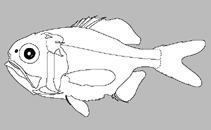Hoplostethus grandperrini Roberts & Gomon, 2012
Grandperrin's giant sawbelly
Upload your photos and videos
Google imageNo image available for this species;
drawing shows typical species in Trachichthyidae.
Google imageNo image available for this species;
drawing shows typical species in Trachichthyidae.
Classification / Names Common names | Synonyms | Catalog of Fishes(genus, species) | ITIS | CoL | WoRMS | Cloffa
Teleostei (teleosts) > Trachichthyiformes (Roughies) > Trachichthyidae (Slimeheads)
Etymology: Hoplostethus: Greek, hoplon = weapon + Greek, stetho, stethion = brest; literal = to prick a little breast (Ref. 45335); grandperrini: Named for Dr René Grandperrin, retired chief scientist of ORSTOM Nouméa, an ardent fish researcher and leader of deepwater fish explorations off New Caledonia (Chef de Mission of research cruises BERYX 2 and HALIPRO2), for his strong support for collaborative fieldwork between French and New Zealand scientists.
Eponymy: Dr René Grandperrin is an oceanographer and zoologist who is now a retired chief scientist of ORSTOM. [...] (Ref. 128868), visit book page.
Etymology: Hoplostethus: Greek, hoplon = weapon + Greek, stetho, stethion = brest; literal = to prick a little breast (Ref. 45335); grandperrini: Named for Dr René Grandperrin, retired chief scientist of ORSTOM Nouméa, an ardent fish researcher and leader of deepwater fish explorations off New Caledonia (Chef de Mission of research cruises BERYX 2 and HALIPRO2), for his strong support for collaborative fieldwork between French and New Zealand scientists.
Eponymy: Dr René Grandperrin is an oceanographer and zoologist who is now a retired chief scientist of ORSTOM. [...] (Ref. 128868), visit book page.
Environment: milieu / climate zone / depth range / distribution range Ecology
Marine; pelagic-oceanic; depth range 500 - 675 m (Ref. 92805). Subtropical
Distribution Countries | FAO areas | Ecosystems | Occurrences | Point map | Introductions | Faunafri
Northwest Pacific: types collected at Seamount 'B' in the northern portion of the Norfolk Ridge, south of New Caledonia and on the south-eastern slope of New Caledonia’s Grande Terre.
Size / Weight / Age
Short description Identification keys | Morphology | Morphometrics
Dorsal spines (total): 6; Dorsal soft rays (total): 13; Anal spines: 3; Anal soft rays: 9; Vertebrae: 26. This species is distinguished by the following characters: pectoral-fin rays 17-18; total gill rakers on outer side of first arch 19-20; abdominal scutes 13-14, scutes rectangular and rugose in large individuals; predorsal scales, 21-24; isthmus no scales; body scales adherent; lateral line scales with strong medial ridge and spine posteriorly and with numerous fine rather long spines in small individuals, scales rugose, lacking a posterior spine in large adults; predorsal midline scales forming very low ridge in small individuals, no ridge apparent in very large individuals; body ovoid and deep, depth 1.8-1.9 in SL; dorsal profile of head gently curved; dorsal- and anal-fin spines of moderate thickness; pectoral fin of moderate length, reaching base of second anal-fin spine in small individuals, to 10th-11th abdominal scute in largest; adults orange-red; buccal cavity mostly white, black only on roof of mouth posteriorly, opercular recess black anteriorly, much paler near periphery (Ref. 92805).
Life cycle and mating behavior Maturity | Reproduction | Spawning | Eggs | Fecundity | Larvae
Main reference
Upload your references | References | Coordinator : Moore, Jon A. | Collaborators
Roberts, C.D. and M.F. Gomon, 2012. A review of giant roughies of the genus Hoplostethus (Beryciformes, Trachichthyidae), with descriptions of two new Australasian species. Memoirs of Museum Victoria 69:341-354. (Ref. 92805)
IUCN Red List Status (Ref. 130435: Version 2024-2)
Data deficient (DD) ; Date assessed: 26 December 2019
CITES
Not Evaluated
Threat to humans
Harmless
Human uses
FAO - Publication: search | FishSource |
More information
Trophic ecology
Food items
Diet composition
Food consumption
Food rations
Predators
Food items
Diet composition
Food consumption
Food rations
Predators
Population dynamics
Growth parameters
Max. ages / sizes
Length-weight rel.
Length-length rel.
Length-frequencies
Mass conversion
Recruitment
Abundance
Growth parameters
Max. ages / sizes
Length-weight rel.
Length-length rel.
Length-frequencies
Mass conversion
Recruitment
Abundance
Life cycle
Reproduction
Maturity
Maturity/Gills rel.
Fecundity
Spawning
Spawning aggregations
Eggs
Egg development
Larvae
Larval dynamics
Reproduction
Maturity
Maturity/Gills rel.
Fecundity
Spawning
Spawning aggregations
Eggs
Egg development
Larvae
Larval dynamics
Anatomy
Gill area
Brain
Otolith
Gill area
Brain
Otolith
Physiology
Body composition
Nutrients
Oxygen consumption
Swimming type
Swimming speed
Visual pigments
Fish sound
Diseases & Parasites
Toxicity (LC50s)
Body composition
Nutrients
Oxygen consumption
Swimming type
Swimming speed
Visual pigments
Fish sound
Diseases & Parasites
Toxicity (LC50s)
Genetics
Genetics
Heterozygosity
Heritability
Genetics
Heterozygosity
Heritability
Human related
Aquaculture systems
Aquaculture profiles
Strains
Ciguatera cases
Stamps, coins, misc.
Aquaculture systems
Aquaculture profiles
Strains
Ciguatera cases
Stamps, coins, misc.
Tools
E-book | Field guide | Length-frequency wizard | Life-history tool | Point map | Classification Tree
| Catch-MSY |
Special reports
Download XML
Internet sources
AFORO (otoliths) | Aquatic Commons | BHL | Cloffa | BOLDSystems | Websites from users | Check FishWatcher | CISTI | Catalog of Fishes: genus, species | DiscoverLife | ECOTOX | FAO - Publication: search | Faunafri | Fishipedia | Fishtrace | GenBank: genome, nucleotide | GloBI | Google Books | Google Scholar | Google | IGFA World Record | MitoFish | National databases | Otolith Atlas of Taiwan Fishes | PubMed | Reef Life Survey | Socotra Atlas | Tree of Life | Wikipedia: Go, Search | World Records Freshwater Fishing | Zoobank | Zoological Record
Estimates based on models
Phylogenetic diversity index (Ref. 82804): PD50 = 0.5000 [Uniqueness, from 0.5 = low to 2.0 = high].
Bayesian length-weight: a=0.01660 (0.00714 - 0.03859), b=3.05 (2.85 - 3.25), in cm total length, based on LWR estimates for this (Sub)family-body shape (Ref. 93245).
Trophic level (Ref. 69278): 3.7 ±0.6 se; based on size and trophs of closest relatives
Resilience (Ref. 120179): Very Low, minimum population doubling time more than 14 years (Preliminary K or Fecundity.).
Fishing Vulnerability (Ref. 59153): Moderate vulnerability (42 of 100).




